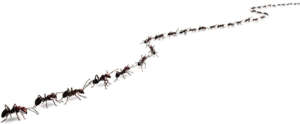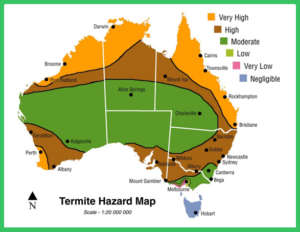Termites@Cooloola & Beach to Bay Pest Management
Termites@Cooloola & Beach to Bay Pest Management

Schedorhinotermes spp. is considered the most damaging species in the Cooloola region. This is due to the highly destructive feeding habits, their timid nature and random nesting habits. This species is very well adapted to urban environment and can be a problem to just about any type of building on any property. Colonies are usually quite large and work very fast.
Nasutitermes spp. can cause as much damage as some of the damaging species however are not usually as sneaky. They quite often build their mud galleries straight up piers and walls, making them easy to spot. They have some very different characteristics and habits that make them easy to identify.
Heterotermes spp. like microcerotermes are slow workers and usually only cause moderate damage to buildings. I very rarely encounter Heterotermes in buildings throughout the Cooloola region however quite often see them in fence posts and timber debris in gardens.
Coptotermes spp. are the most economically significant species in Australia. This is mainly due to this species being found in most areas across the entire mainland of Australia. They survive in highly organised colonies that can reach out hundreds of meters. Colonies are usually extremely large and work very fast.
Microcerotermes spp. can cause moderate damage to buildings and timber in service however are slow workers and are usually noticed before significant damage is caused.
Drywood Termites live in the warmer areas of Australia, where there is a humid atmosphere. They can exist in any wooden part of a building from ground to roof, in furniture, ornaments or paper articles. Drywood termites are very different to subterranean species in many ways. They do not make mud galleries and don't need to have any connection with the ground. They live inside the timber they are attacking and obtain all their moisture requirements from that timber. They have very small colonies of only a few hundred members but may reinfest to create thousands of separate colonies.
There are many species of Dampwood termite in Australia. Their nesting habit is much like the drywood termite however they require damp and decaying timber and do not produce faecal pellets. Because of their moisture requirements very rarely do they cause damage to homes. If you have this termite in your house than you will also have bigger issues with moisture.
Termites are social insects that feed on Cellulose, a material found in wood, plants and grass. Although their more closely related to a cockroach than an ant they are often known as “white ants” in Australia. In their natural habitat, they are very beneficial to the environment. They are nature’s recyclers, breaking down cellulose and returning nutrients to the soil. However, when they infest buildings and homes, they can cause significant structural damage.
Termites can enter buildings through cracks, expansion joints, hollow bricks or concrete blocks and around plumbing. Any building, whether built with slab, basement or on piers, can be targets for termite infestation. The Cooloola region is considered one of the highest risk areas in Australia for termite attack on homes. This is due to the Sub tropical climate, predominately-sandy soil and numerous other environmental factors that make your home a good home for termites.
Out of approximately 300 Termite species found in Australia, less than twenty of these species will attack timber in service. Termites are grouped into three main lifestyle categories, Dampwood Termites, Drywood Termites and the most common Subterranean Termites. In the Cooloola region we encounter seven separate species (five of these subterranean).
Subterranean termites are the most common species found in this area. The worker termites construct mud tunnels, which are used to explore for food and connect their nest to that food source. They also use these mud tunnels to enter a building where there is no direct soil/wood contact. Their colonies are quite often located in the soil however can be in trees or mounds.
Dampwood Termites live in tree stumps and areas where timber is in contact with moist
soil. They can also be found in wall cavities and beneath houses, anywhere where a sustained moisture supply is. These termites generally do not form one large central colony but live in many small separate groups.
Drywood Termites live in the warmer areas of Australia, where there is a humid atmosphere. They can exist in any wooden part of a building from ground to roof, in furniture, ornaments or paper articles. They do not need contact with soil and do not need any other source of moisture other than the water obtained from the wood in which they feed. As with Dampwood Termites they live in small colonies contained in the infested timber however can split off into many separate nests. The world’s most destructive Drywood termite, “The West Indian Drywood Termite” cryptotermes brevis has caused considerable economic damage in Queensland towns including Maryborough. If this particular termite species is found necessary treatment is undertaken and supervised by the government (DAFF), as it is classed as “a notifiable disease under the Diseases in Timber Act 1975”.
Map supplied by CSIRO Australia.

The Queen: The role of the queen is to reproduce and sustain the colonies population.
She may lay more than a thousand eggs per day depending on her age, vigour and species. When in her prime the queen can often become longer than 30mm in size (some species up to 100mm). The queen and king may live for over 20 years. A “Physogastric Queen” will encounter an enlargement of her ovaries . This increases the production of the eggs (into the thousands per day) and causes her abdomen to become enlarged, which reduces her movement capabilities.
Workers: Worker termites have many responsibilities. They are to find and gather food, build and maintain nests and workings. As well, as feed the colony and nurse the eggs and nymphs. They are wingless, blind and sterile.
Soldier Termites: The role of soldier termites is to defend the colony from ants and other invaders.
Alates: Alates are future Kings or Queens. When fully winged they leave their parent colony in search for suitable nesting sites to start new colonies. Although this may happen during other months of the year, they generally take flight in the earlier summer months of November to December when the temperature is humid and simular to that of their nest. They are usually darker in colour and have formed compound eyes. After the colonising flight, they drop their wings and the males follow the females to a suitable nesting area, somewhere moist with decaying wood, such as a base of a tree.
Termite Lifecycle
Incomplete metamorphosis

Termites do not eat hardwood.
We have heard this myth many times. Although most wood eating termites prefer softwood they will still eat hardwood.
Termites are happy in my Garden, there is plenty to eat.
Wood eating termites will be very happy in your garden especially if there is plenty to
eat. In fact, they will be so happy that the Queen will produce more termites and expand the colony, then move on into your home.
Woodchip….stumps ….. fire wood….. scrap timbers …..any untreated timber that is in soil contact is regarded by termites as easy FOOD.
Food (AKA timber) attracts foraging termites and sends the Queen a message…hey mum !
plenty of food lay some more eggs… result is MORE TERMITES looking for MORE
FOOD….possibly your house !
Remember Newterms Law: T = TP2
Timber = Termite population2
Termites cannot eat my house its brick, built on a concrete slab or steel framed.
Any home, whether built with brick, on a concrete slab or even steel framed house, can be targets for termite infestation. They may not eat the steel or concrete but they will feed on skirting boards, doors, gyprock, furniture and many more parts of your home.
Termites will not eat treated timber.
Termites under certain circumstance will eat treated timber. Treated timber that has been affected by moisture or that wasn't originally treated correctly, could be consumed by termites. Termites have also been known to eat the centre of the timber leaving only the outer treated timber behind. There are also different Hazard ratings for treated timber, H1 - H9. Adrian has witnessed termites eat up to a Hazard 5 treated timber. See images adjacent. Most building construction timber is only rated to H2 and not highly termite resistant.
We don't need a termite inspection as we have termite protection.
Whether you live in a new home with a physical Termite Barrier or an existing home that has had a chemical barrier installed, you will find that most warranties state that regular inspections must done to comply. If you fail to have your recommended inspections done, your warranty is likely to be invalid, and any termite damage will be your responsibility.
My house insurance will cover termite damage.
Check your insurance policy, you will find that you are not covered for damaged caused by termites. Most home insurance companies do not offer insurance for termite damage. Be aware, termites are the homeowners’ responsibility.